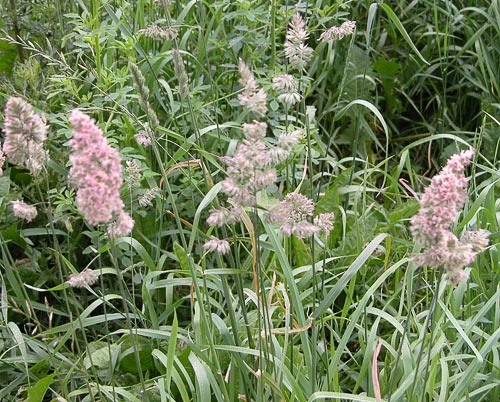Crops
Dactylis glomerata L. - Cock.s-foot grass, orchard grass.
Taxonomic position.
Family Poaceae Barnhart., genus Dactylis L.Biology and morphology.
Chromosome number: 2n = 14, 28, 42. Perennial plant, robust, hairless, cespitous. Stems erect, 35-160 cm high, compressed at the base. Blade folded when young, large (4 - 12 mm), quite stiff, long up to 30-40 cm, with no visible nerve, hulled at the top. Ligule very big, irregular, torn, white. No auricles. Inflorescence is stiff panicle, spreading or dense, erect, with basal branches without spikelets over a long area. Spikelets 3-6 flowered, 5-6 mm long, in compact clusters. The weight of 1000 seeds is 0.8 to 1.3 g. Blossoms in June, seed ripening - July. Cross-pollinated by wind.Distribution.
Introduced into culture since the end of XIX century. Cultivated on small squares in the forest, steppe and mountain areas at 74 regions and republics of former USSR countries. 20 breeding cultivars for forage and pasture purposes have the state permission for utilization.Ecology.
Mesophyte, adapted to large climate range. This grass is able to withstand ponding for up to one month and is tolerant of waterlogged soils. Not enough cold-resistant and frost-resistant. Resistant to early fall and late spring frosts. Drought resistant. Optimum on normally drained to dry soils. Can grow on slopes, on shallow, very dry soils. Dislikes excessive humidity. Wide range for nutrient availability. Can grow on rather poor soils but much more productive on rich soil. Its strong root system can develop over a big volume of soil and thus absorb more nutrients than the other species of the same community. Quite large range for pH. Thrives on slightly acid to alcaline soils. Quite indifferent to soil texture.Utilization and economic value.
One of the best grasses for hay, haylage, silage. Valuable component of grasses mixtures for cultural long-lived pastures. Combines well with clovers and alfalfa. Regrows in the end of April and that.s why it is good for grazing in the first part of May or for early harvest. Good regrowth after 3-5 grazings. Nutritive value is equal to that of Phleum pratense and Festuca pratense. Used as a lawn culture. Improves soil fertility and structure. Improves soils structure and fertilization. Forage mass productivity ranges from 33-66 MT/ha, hay productivity ranges 7,5-11,5 MT/ha and seed productivity is 400-500 kg/ha.Literature:
Catalog of state permitted cultivars of agricultural crops. 1969. - M.: Kolos, 489 pp. (in Russian).Catalog of state permitted cultivars of agricultural crops. 1971. - M.: Kolos, 488 pp. (in Russian).
Catalog of state permitted cultivars of agricultural crops. 1974. - M.: Kolos, 480 pp. (in Russian).
Catalog of state permitted cultivars of agricultural crops. 1985. - M.: Kolos, Vol 3. - 489 pp. (in Russian).
Catalog of agricultural crops. cultivars permitted in Byelorussia. 1985. - Minsk: Uradjai, 176 pp. (in Russian).
Golovkin B. N. 1988. Cultigenic plant area. - M.: Nauka, 184 pp. (in Russian).
Medvedev P. F., Smetannikova A. I. The forage crops of European part of the USSR. 1981. - L.: Kolos, 336 pp. (in Russian).
Shashko D. N. Agroclimatic region of the USSR. 1967. - M.: Kolos, 335 pp. (in Russian).
Shashko D. N. Agroclimatic resources of the USSR. 1985. - M.: Kolos, 248 pp. (in Russian).
Soil resources of the USSR (Agricultural regions of areas and republics of USSR). 1990. - M.: - Vol 1. - 260 pp. (in Russian).
State register of Ukrainian plant cultivars. 1992. - Kiev: Urojai, 199 pp. (in Russian).
State register of breeding achievements permitted for utilization. Plant cultivars. 1994. - M.: - 218 pp. (in Russian).
State register of breeding achievements permitted for utilization. Plant cultivars. 1996. - M.: - 171 pp. (in Russian).
State register of breeding achievements permitted for utilization. Plant cultivars. 1999. - M.: - 192 pp. (in Russian).
State register of breeding achievements permitted for utilization. Plant cultivars. 2000. - M.: - 232 pp. (in Russian).
State register of breeding achievements permitted for utilization. Plant cultivars. 2001. - M.: - 252 pp. (in Russian).
State register of breeding achievements permitted for utilization. Plant cultivars. 2003. - M.: - 236 pp. (in Russian).
The Natural-agricultural regions and utilization of soil resources of the USSR. A. N. Kashtanov (ed.). 1983. - M.: Kolos, 336 pp. (in Russian).
The register of plant cultivars in Ukraine. 1996. - Kiev: Urojai, 259 pp. (in Russian).


